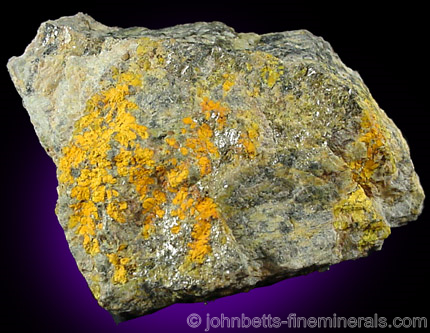Gummite

Gummite is not a definitive mineral species, but rather an unspecific mixture of
secondary uranium minerals, especially Becquerelite, Boltwoodite, Clarkeite, Curite, Fourmarierite, Kasolite, Soddyite, and Uranophane. It lacks a definitive
chemical formula and
crystal structure, though it is still listed as a mineral in many mineral guides.
Gummite forms from the
oxidation of
Uraninite and is present in most uranium deposits. It often forms as a partial
alteration of Uraninite, where the inner core remains dull-colored Uraninite, and the outer layers as brightly colored Gummite. The origination of the name Gummite is unknown, but it is presumably named for its rubber or gum-like consistency. Gummite is a
radioactive mineral, and should be stored with all the precautions exercised with radioactive minerals.
Chemical Formula
Lacks definitive chemical formula
Color
Red, orange, yellow, and brown; often multicolored in splotchy patches
Properties
Streak
Light yellow to light orange |
Hardness
2.5 - 5 |
Transparency
Slightly translucent to opaque |
Specific Gravity
3.9 - 6.4 |
Luster
Resinous, Waxy, dull |
Cleavage
None |
Fracture
Uneven |
Tenacity
Brittle |
Other ID Marks
Gummite is radioactive. |
Crystal Habits
Most often massive and as encrusting. Also in rounded and grainy masses and compact form, as well as in embedded dendritic formations.
Varieties
-
Brown formation of Gummite from Spruce Pine, North Carolina, that forms between yellow Gummite and black Uraninite.
-
Gummite from the Elias mine, Jáchymov, Czech Republic.
Uses
Gummite is an ore of uranium in uranium deposits. Mineral specimens are sometimes sliced and polished to show embedded color patterns of Gummite within the matrix.
Noteworthy Localities
The most important locality for this mineral is the Ruggles Mine, Grafton, New Hampshire, where the Gummite is found in yellow masses associated with altering Uraninite and in association with dendritic Uraninite. Other localities that have produced specimens in collections include Spruce Pine, Mitchell Co., North Carolina; and the Luiswishi Mine, Lubumbashi, Katanga Copper Belt, Democratic Republic of Congo; and Jáchymov, in the Karlovy Vary region of Bohemia, Czech Republic.
Distingushing Similar Minerals
None